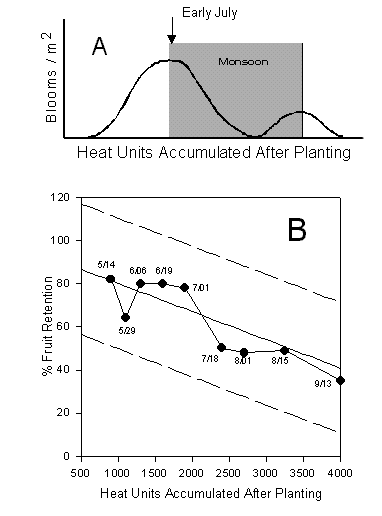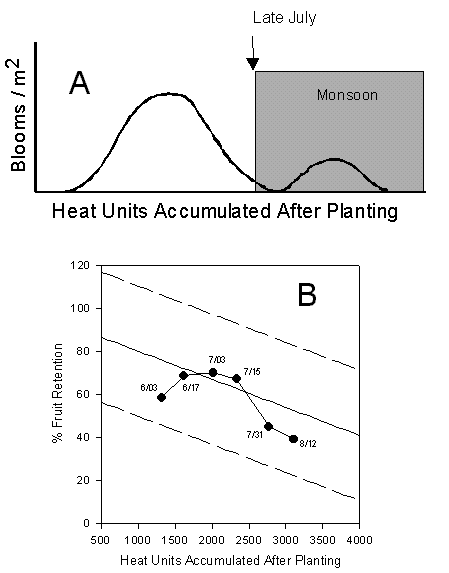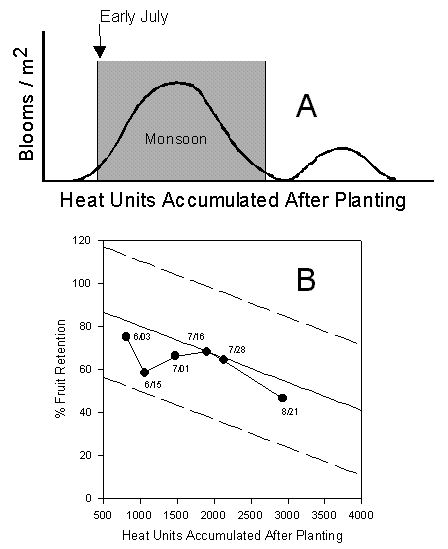Fruit Retention and Monsoon/Heat Stress Relationships
by Jeffrey C. Silvertooth,
Extension Agronomist - Cotton
Weather was one of several important factors impacting the outcome of the 1998 Arizona cotton season. The cotton production season began with the very cool and wet conditions encountered over much of Arizona in the spring, resulting in a substantial delay in planting crop development in many areas. As with many seasons in Arizona, the beginning of the infamous monsoon season of the desert Southwest, typified by high temperatures, high humidity (dewpoint temperatures in excess of 55 OF), and accelerated rates of fruit abortion, brought additional troubles to many Arizona farms. The extent of additional fruit abortion and yield loss associated with the monsoon season is always a matter of concern yet it is difficult to quantify for any given farm or field. The past three seasons in Arizona have offered very contrasting patterns with respect to the onset of the monsoon season, the stage of growth of the crop, and the response of cotton fields to those conditions. Relevant contrasts among seasons are perhaps worth considering.
There are three basic stages in the fruiting cycle where the onset of the monsoon may theoretically have distinctly different impacts on the crop. Probably the worse scenario would be to encounter the beginning of the monsoon season when the crop is at peak bloom, carrying a good boll load (high FR), and as a result experiencing a natural (self-induced) carbohydrate stress due to the demands of the developing fruit load. This was basically the case for many fields in central Arizona in 1996 when the monsoon season began in early July (Figure 1). A much better scenario would be to have the crop very near the end of the first fruiting cycle before the beginning of the monsoon season. In 1997 many fields in central Arizona were very close to the end of the first fruiting cycle when the monsoon season began in later July (Figure 2). In 1998 the monsoon season began in early July similar to 1996. However, the 1998 crop was delayed due to cool spring weather and was just beginning to bloom in many areas when the monsoon arrived at the beginning of July (Figure 3). Therefore, many fields in central Arizona in 1998 were forced to develop through the entire fruiting cycle under rather adverse, monsoon-type conditions.
Figures 1, 2, and 3 provide in each case: A) the general relationship of the monsoon season to the fruiting cycle experienced in that season; and B) the FR patterns measured at a common location in central Arizona with a common set of varieties in each of those three seasons. As a matter of comparison, these three cases offer some rather interesting contrasts. In 1996 (Figure 1) a sharp decline in FR was experienced in early July coinciding with the beginning of the monsoon. The crop was probably destined to experience some loss in FR due primarily to the large boll load that was being developed, but the relationship to the monsoon weather was distinct. Final yields in this case in 1996 averaged about 3.1 bales/acre. Similarly, the 1997 crop experienced a drop in FR in late July with the start of the monsoon, but yields were still very good (3.5 bales/acre). The 1998 case (Figure 3) never experienced high FR levels, but it also never experienced any major losses or changes in FR. The 1998 crop was able (forced) to acclimate to the monsoon-type weather conditions throughout the fruiting cycle and seemed capable of maintaining fair levels of FR. Final yields in 1998 averaged about 3.0 bales/acre for this case in central Arizona. Even though final FR levels were similar in 1997 and 1998, the lower yields in 1998 may be due in part to other factors such as a reduced number of seeds per boll and limitations in fiber development.
In conclusion, I suggest that we should still strive toward production
strategies that provide the best chance of accomplishing an early crop
(e.g. Figure 2). However, having no control over the
weather, if we are forced to deal with a delayed planting for any reason,
planting more determinate varieties, including those that seem to be better
adapted to the heat, could help us deal with the weather conditions commonly
associated with the monsoon. Another option would be to attempt to produce
a top-crop with a late season fruiting cycle which will increase the cost
of production.

Figure 1. Monsoon pattern (A) and fruit retention levels (B) for central
Arizona, 1996.

Figure 2. Monsoon pattern (A) and fruit retention levels (B) for central
Arizona, 1997.

Figure 3. Monsoon pattern (A) and fruit pretension levels (B) for central
Arizona, 1998.
Issued in furtherance of Cooperative Extension work, acts of May 8 and June 30, 1914, in cooperation with the U.S. Department of Agriculture, James A. Christenson, Director Cooperative Extension, College of Agriculture and Life Sciences, The University of Arizona.
The University of Arizona is an equal opportunity, affirmative action institution. The University does not discriminate on the basis of race, color, religion, sex, national origin, age, disability, veteran status, or sexual orientation in its programs and activities.
Any products, services, or organizations that are
mentioned, shown, or indirectly implied in this web document do not imply
endorsement by The University of Arizona.
Information provided by Jeffrey C. Silvertooth, silver@ag.arizona.edu
Extension Agronomist - Cotton, College of Agriculture, The University of Arizona.
Material written 14 November 1998.
Home | Cotton | Advisories
document located at: http://cals.arizona.edu/crops/cotton/comments/nov1998cc.html
Copyright © 2001 University of Arizona,
College of Agriculture and Life Sciences
Webmaster: Al Fournier (acis@ag.arizona.edu)